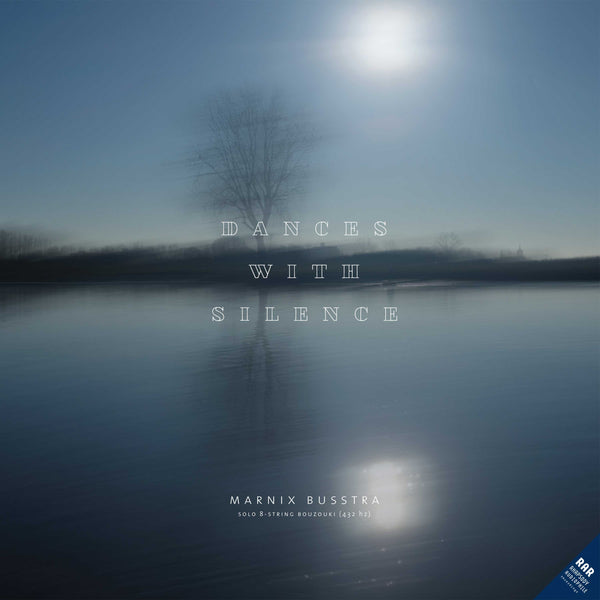Marnix Busstra - Dances with Silence (RAR)
Tax included
"....The reason I chose to record this album in 432 Hz tuning was purely based on intuition; this tuning simply felt right, with this instrument in this setting."
- Marnix Busstra
Marnix Busstra - 8 string bouzouki
Total time: 39:19
The original recording (44kHz-24bit) is analog mixed and mastered to tape 15 inch/s (Studer A80).
Mastered by an HQ analog chain to PCM352kHz-32bit.
All other formats are converted versions of the original master.
Rhapsody Audiophile Recordings presents:
DANCES WITH SILENCE
On a summer day in 2001 I wandered through the vibrant heart of Amsterdam and visited one of my favorite music stores, Hampe Music (nowadays known by the name Prinz Guitars), specialized in acoustic string instruments. I spotted a bouzouki and my heart was sold; what a beautiful, extraordinary instrument!
The bouzouki is originated in Greece, but was adapted in the ‘60s to Irish folk music. The eight-string bouzouki I found turned out to be such an Irish instrument, from the brand ‘Fylde.’ With not a single doubt in my mind I pulled out my credit card and took it
home.
Being a jazz/fusion guitar player, I’m not well versed in Irish or Greek folk music, so I use the bouzouki differently than customary. Beside jazz I have a great love for Indian music, I played the Indian sitar for a few years and studied Indian music. In this music tradition it’s custom to use a so-called bourdon or drone accompaniment, for example with a tempura, to create a constant root note. I found out that it’s possible to tune the bouzouki in such a way that you can get drone tuning from the lower sounding strings. This way it sounds more or less like an oriental instrument, it creates a very intriguing, almost hypnotic sound.
For many years the bouzouki was an ‘instrument on the side’ for me, as you’d say. I used it in studio recordings and performances often for not more than one or two songs, just to create a different atmosphere.
In 2020, due to the corona lockdown, everything stopped and all of a sudden I had an empty calendar. At first I was very upset, but gradually I got more room and peace in my mind. Then the idea came up to use the empty pages in my calendar to make a solo album. For me the void and desolation of the lockdown matched the specific vibe of the bouzouki, so I decided to investigate if it was possible, despite the limited possibilities of the instrument with my specific tuning, to make a solo album with it.
Dances With Silence is the result of that endeavour. The title of the album has an ambiguous meaning to me; it’s about the challenge of dealing with the forced, involuntary vacuum of the lockdown, but also about what the instrument taught me. I recorded the musical ideas I had, and time and again I learned it works best to create as much airiness and serenity as possible in the musical pieces. Just as light is only meaningful in the shadow of darkness, sound only gains meaning in its contrast to silence.
The three pieces with the title Dances With Silence (minor, major and lydian) are a little ode to the unique identity of these scales. Each one of them has its own particular character, which I’ve tried to capture.
I’ve chosen to play everything in the 432 Hz tuning. There is a lot of controversy about this tuning; from proponents who believe this tuning is a healing, spiritual remedy, to opponents who claim this to be total nonsense. The reason I chose to record this album in 432 Hz tuning was purely based on intuition; this tuning simply felt right, with this instrument in this setting. Last but not least, I would like to mention the label RAR, Rhapsody Audiophile Recordings. It’s been a few years since a couple of my jazz albums were recorded and released by the high-end label Turtle Records. Working with Harry van Dalen at the time was very inspiring, so when I heard he had started a new label, based on analogue recording technique (of which I’m a big fan!), it made perfect sense to me to work with him once more.
This renewed cooperation resulted in Dances With Silence. Enjoy the music!
- Marnix Busstra
1 Dance with silence: minor
This first Dance With Silence is devoted to the minor scale. It’s one of the most versatile scales, you can create a lot of different colors and express all kinds of emotions with it. The minor key is often associated with solitude and sorrowful sentiment, but also with hope and acceptance. In this improvisation I tried to capture these aspects.
2 Somewhere over the rainbow
One of the most loved standards of the American Songbook. It has been covered numerous times, but to my knowledge it has never been done by solo bouzouki.
In this arrangement the entire song maintains the same root note, which is different then the original composition.
3 Little boy on the hill
I wrote this song in 2001, it’s one of the first compositions I made for the bouzouki. The title is inspired by an experience I had on a trip to Tibet, where on arrival in a small village I caught sight of a small boy, about ten years old, standing on a hill with his arms crossed, waiting for what would happen next. He looked so calm and balanced, somehow he made a strong impression on me. I love playing this one, it definitely belongs on this album.
4 Along the dirt road
This bluesy piece is not really a composition, but more like a free improvisation. The blues has always been very important to me, when I play the guitar the blues is never far away. I was amazed to find out the bouzouki is well suited for the blues too! The title of this song came from what one of my daughters heard in it: a lonely wanderer on the side of a dirt road.
5 The chord
Sometimes, one chord keeps an entire world hidden in it. This certainly applies to this harmony (D-Bb-F#-A), in which different musical elements are unified. That’s why this chord immediately raises all kinds of questions. This piece is a free improvisation to this harmony.
6 Fields of gold
One of my favorite Sting songs, a composition that works really well on this instrument. Due to the specific tuning I use, the arrangement is inevitably completely different than the original piece. The beauty of such a powerful melody is that it can last in any musical setting.
7 Dance with silence: major
This second Dance With Silence is dedicated to the major scale. The minor and major scale are the most frequently used scales, at least in Western music. They represent two completely different worlds, in a way they are each other’s counterparts. I’ve tried to express the positive vibe which is so characteristic to the major scale.
8 Peaceful daydream
Just like Little Boy On The Hill this is a slightly older piece, I wrote it on a quiet Sunday afternoon in my backyard. It has the feel of a sweet, intimate dance, celebrating the peaceful side of life. I frequently played it as a duet accompanied by double bass, it also works very well as a solo piece.
9 The mighty hunter
For this composition I down tuned the strings of the bouzouki, which makes the instrument sound huge, as if the resonance chamber is much bigger than it actually is. It creates a strong and powerful feeling, there is no escaping it.
10 Norwegian wood
One of my favorite Beatles songs, genius in its simplicity. It’s a legendary piece, the first time an Indian sitar was used in a pop song.
11 She’s always a woman
A brilliant composition by Billy Joel, with a stunning harmonic course throughout it. Sometimes I can be really jealous when someone composes such a sublime piece...
12 Dance with silence: lydian
This third Dance With Silence is devoted to the lydian scale, one of the diatonic church scales. Actually, major and minor scales are also church scales, their original names are respectively ionic and aeolic. This lydian scale has its own unique character, it sounds somewhat "floaty", not quite "grounded". I’ve tried to express these characteristics in this improvisation.
The RAR team at work
Oftentimes there is a big difference between the initial studio recording and the final end product. Before a final master is made, many recordings get processed with numerous mastering plugins in order for the audio to be playable on any type of equipment, from a tiny smartphone speaker to a full blown high-end audio system. For audiophiles with good audio reproduction systems this method is not ideal.
At RAR we are trying to close the gap between what is captured live in the studio and the final master. We want to bring the experience of a live performance directly into the homes of music and audio lovers. We aim to have you experience what the musicians hear when the music is being created. All the emotion, all the excitement as well as the extreme dynamics that the musicians use in order to make the music come alive.
- Michael van Polen, Harry van Dalen & Frans de Rond
Being reintroduced to tape as a mastering tool by Harry and Michael has been a very rewarding and inspiring experience. The warmth and immediacy of the tape sound is so fresh and real, but also with a hint of melancholia….this is the sound that I grew up with, the sound with which I learned my trade. But now with the advantage of superb analog mic preamps, a completely overhauled and adjusted Studer tape recorder, the sound is even better than I remember. It is different but at least as good as what we are doing with the Sound Liaison DXD recordings. I even mastered a few of our DXD recordings (Embrace Me and Ray!) to tape as I found that it gave those recordings just that little extra mojo needed."
- Frans de Rond
For more information about Rhapsody Audiphile Recordings; www.rhapsodyaudiophilerecordings.com
Analog mastering and sound production: Michael van Polen
Digital mastering: Frans de Rond
Mentoring: Harry van Dalen
Cables and field elimination protectors: Rhapsody high-end audio systems
Sleeve design: Kees Schreuders
Photography cover: Kees Schreuders
Recording period: nov 2020 - febr 2021
Recorded and mixed at: Landscape Sound Studio, Broek in Waterland
Mixing engineer: Norbert Sollewijn Gelpke
Cutting engineers: Rinus Hooning & Martijn Schouten
HQ vinyl pressing: Artone studio
Mastering headphones: Hifiman HE1000se / Sennheiser HD800S
All power cables and power conditioners by AudioQuest
Network Switch by SOtM
Catalog Number: SL-1071A

